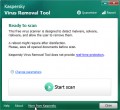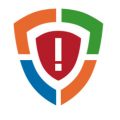If you have recently noticed that your files have been renamed with a “Cosw” extension and are unable to open them, it is highly likely that your computer has been infected with the Cosw ransomware. This malicious software encrypts your files and demands payment in exchange for the decryption key. In this article, we will discuss what the Cosw ransomware is, how it works, and what steps you can take to try and recover your files.
Files encrypted by the Cosw virus:
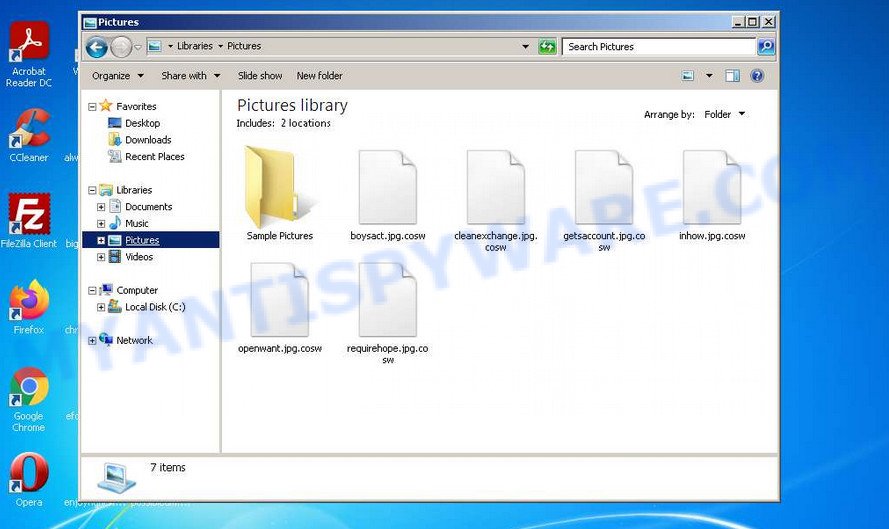
QUICK LINKS
- What is Cosw virus?
- Remove Cosw virus (ransomware)
- Decrypt .Cosw files
- Restore .Cosw files
- Video Guide
What is the Cosw ransomware?
The Cosw ransomware is a type of malware that belongs to the Djvu/STOP ransomware family. It typically infiltrates a victim’s computer via spam emails, fake software updates, or software cracks. Once installed, it starts encrypting the victim’s files using a combination of AES and RSA encryption. The encrypted files will have the .cosw extension added to them.
The ransomware targets a wide range of file types, including documents, photos, music, videos, and archives. However, it avoids encrypting system files to ensure the computer is still functional enough to display the ransom note.
After the encryption process is complete, the ransomware drops a ransom note named “_readme.txt” in each folder containing the encrypted files. The note explains that the victim’s files have been encrypted and provides instructions on how to pay a ransom to receive the decryption tool. The ransom note also includes an email address to contact the ransomware operators and a unique ID assigned to the victim.
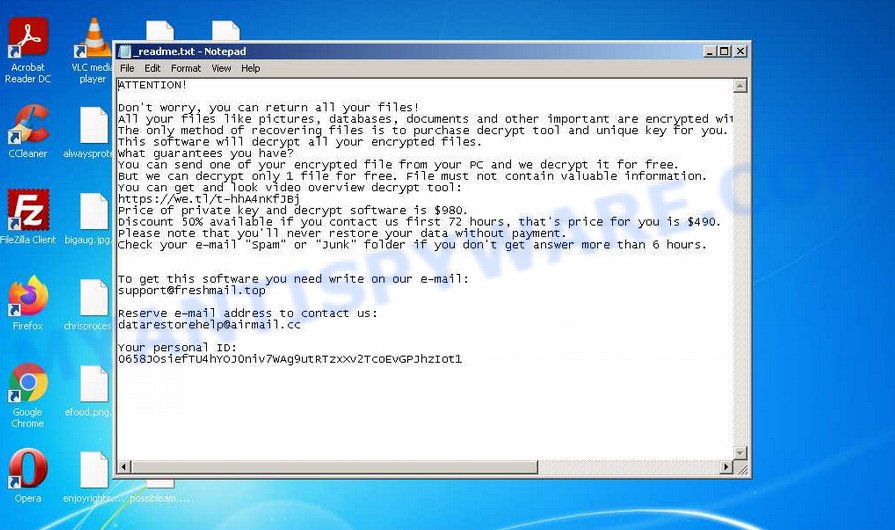
Text presented in the ransom note:
ATTENTION!
Don’t worry, you can return all your files!
All your files like pictures, databases, documents and other important are encrypted with strongest encryption and unique key.
The only method of recovering files is to purchase decrypt tool and unique key for you.
This software will decrypt all your encrypted files.
What guarantees you have?
You can send one of your encrypted file from your PC and we decrypt it for free.
But we can decrypt only 1 file for free. File must not contain valuable information.
You can get and look video overview decrypt tool:
https://we.tl/t-hhA4nKfJBj
Price of private key and decrypt software is $980.
Discount 50% available if you contact us first 72 hours, that’s price for you is $490.
Please note that you’ll never restore your data without payment.
Check your e-mail “Spam” or “Junk” folder if you don’t get answer more than 6 hours.To get this software you need write on our e-mail:
support@freshmail.topReserve e-mail address to contact us:
datarestorehelp@airmail.ccYour personal ID:
0658xxxxxxxx
Unfortunately, there is currently no known way to decrypt files encrypted by the Cosw ransomware without paying the ransom. However, in some cases, victims have been able to recover their files using backups or by using data recovery tools. Additionally, if the victim’s files were encrypted with an offline key, decryption may be possible. Victims can use the STOP Djvu decryption tool provided by Emsisoft to check if their files can be decrypted without paying the ransom.
It’s important to note that even if a victim pays the ransom, there is no guarantee that they will receive the decryption tool or that the tool will work properly. Therefore, it’s always recommended to have proper backups of important files and to take preventative measures to avoid being infected with ransomware in the first place.
Threat Summary
| Name | Cosw ransomware, Cosw file virus |
| Type | Ransomware, Crypto malware, File locker, Filecoder, Crypto virus |
| File extension | .Cosw |
| Ransom note | _readme.txt |
| Contact | support@freshmail.top, datarestorehelp@airmail.cc |
| Ransom amount | $980 or $490 in Bitcoins |
| Detection Names | TrojanX-gen [Trj], Win.Packer.pkr_ce1a-9980177-0, Trojan.Win32.Azorult, VHO:Trojan.Win32.Agent.gen, W32.AIDetectNet.01, TrojanRansom.Blocker.c, Ransom.Stop.P5, Trojan.Win32.Save.a, Ransom.Win32.STOP.SMYXDBTB.hp |
| Symptoms | Your documents, photos and music fail to open. Your personal files have odd extension appended at the end of the file name. Files named such as ”, ‘READ-ME’, ‘_open me’, _DECRYPT YOUR FILES’ or ‘_Your files have been encrypted” in every folder with an encrypted file. You have received instructions for paying the ransom. |
| Distribution methods | Phishing emails that contain malicious attachments. Drive-by downloads (ransomware virus is able to infect the personal computer simply by visiting a web-site that is running harmful code). Social media, such as web-based instant messaging programs. Malvertising campaigns. |
| Removal | Cosw virus removal guide |
| Decryption | Cosw File Decrypt Tool |
How to remove Cosw virus (ransomware)
To successfully decrypt or recover .Cosw files, it is essential to eliminate Cosw ransomware and its autostart entries. Failing to do so may result in the ransomware re-encrypting the restored files. Stopping the ransomware is a straightforward process and can be accomplished through various methods. One way is to perform a complete system scan using malware removal tools that can detect and remove ransomware infections for free. To make the process more convenient, consider reading this entire guide and saving it on your smartphone or printing it out. This way, you will have easy access to all the necessary steps.
Scanning your computer for malware is crucial since security researchers have discovered that Cosw ransomware may install spyware alongside it. Spyware poses a significant security risk as it can steal sensitive information like passwords, login credentials, and contact details from the user. If you encounter any issues removing the Cosw virus, feel free to inform us in the comments section, and we will attempt to assist you.
To remove Cosw ransomware, follow the steps below:
Kill Cosw virus
Press CTRL, ALT, DEL keys together.
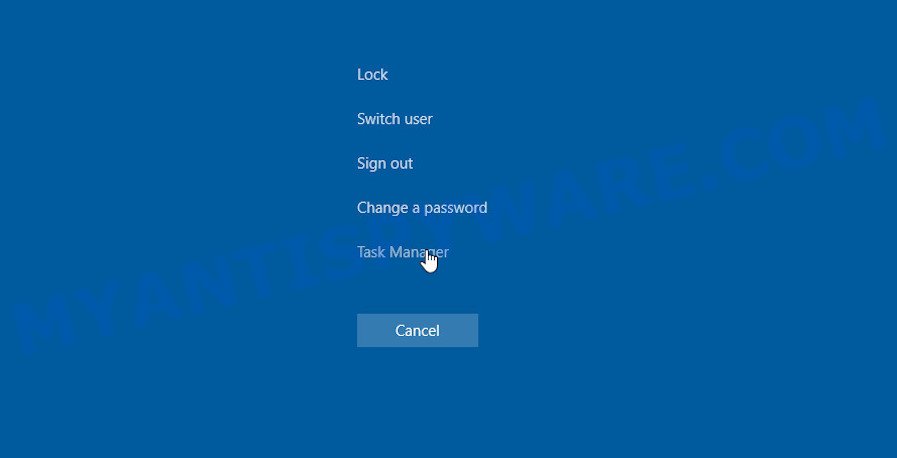
Click Task Manager. Select the “Processes” tab, look for something suspicious that is the Cosw ransomware then right-click it and select “End Task” or “End Process” option. If your Task Manager does not open or the Windows reports “Task manager has been disabled by your administrator”, then follow the guide: How to Fix Task manager has been disabled by your administrator.
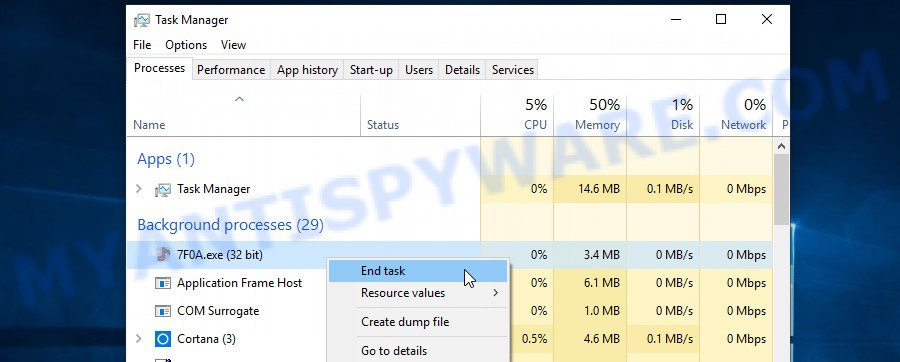
It is not difficult to detect a process related to the Cosw ransomware. When looking for a malicious process, pay attention to the process icon and its name. Most often, this ransomware has a process name in the following format: 4-characters.tmp.exe or 4-characters.exe. For example: 7533.tmp.exe, A4b1.exe, CD15.tmp.exe, 19b2.exe. The process name can also contain “(32 bit)”. If you do not find a process with a similar name in the list of processes, then most likely the Cosw ransomware has finished working. But keep in mind, if you do not remove the ransomware autostart entries, as demonstrated below, and do not delete its file, then after a while it may start again, and if it finds unencrypted files, immediately encrypt them.
Disable Cosw Start-Up
Select the “Start-Up” tab, look for something similar to the one shown in the example below, right click to it and select Disable.

Close Task Manager.
Delete Cosw Task
Type “Task Scheduler” in the search bar. Click Task Scheduler app in the search results. Click “Task Scheduler Library” in the left panel. On the right panel, right-click to “Time Trigger Task” and select Delete.
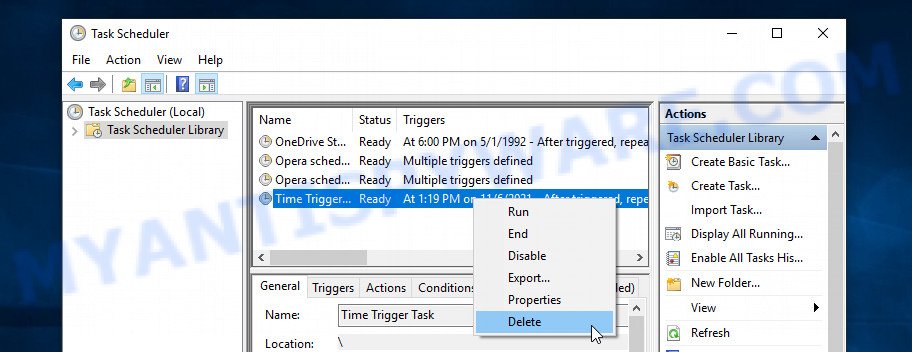
Close Task Scheduler.
Remove Cosw virus
Run Task Manager and select the “Start-Up” tab. Right click to the Cosw ransomware Start-Up entry and select Open File Location as shown below.

A directory containing one file will open in front of you, this file is the Cosw virus. It needs to be removed. If you try to delete it immediately, then you will not succeed, since this file is protected from deletion.
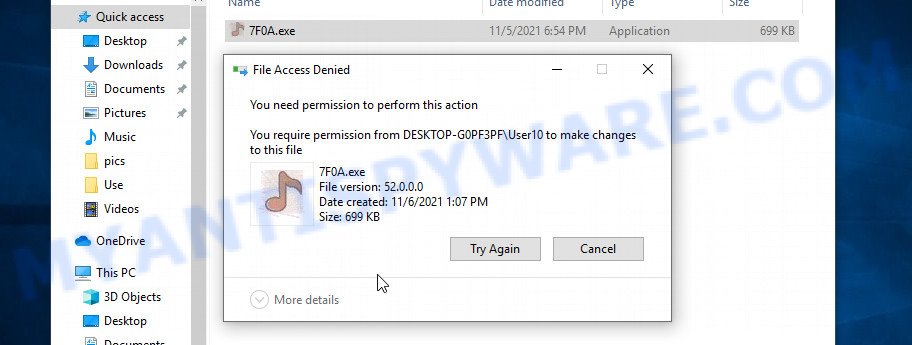
To delete this file, you need to do the following. Right-click on the file, select Properties. In the window that opens, select Security tab. Next, click the Advanced button below. A window will open as shown in the following example.
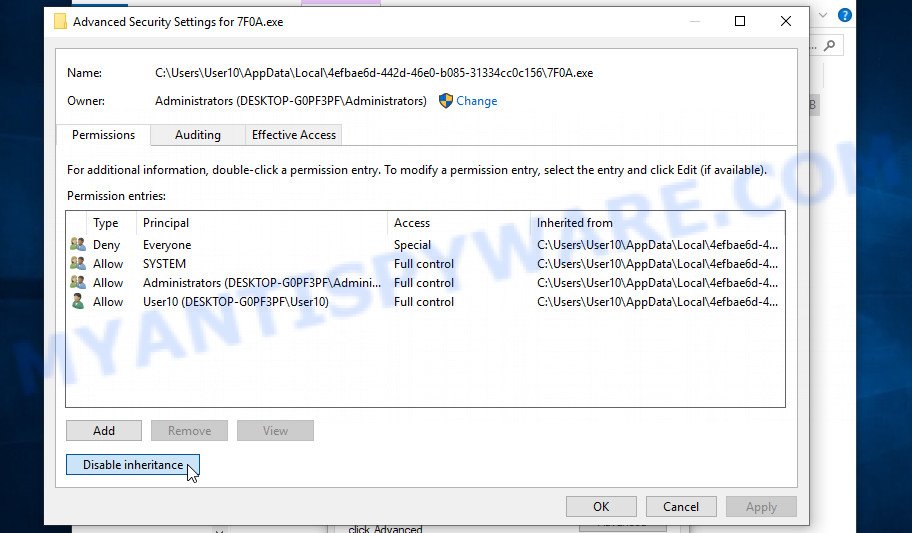
Click Disable inheritance. In the Block inheritance dialog box that opens, select the first item (Convert inherited permissions…) as shown below.

In the Permission entries list, select “Deny Everyone”, click Remove button and then OK. Close the file properties window. You should now be able to remove the Cosw virus. Right-click on the file and select Delete.
Scan computer for malware
We recommend using MalwareBytes which will completely remove the ransomware from your computer. This tool is an advanced malicious software removal program created by (c) Malwarebytes lab. It uses the world’s most popular antimalware technology. MalwareBytes Antimalware is able to help you remove ransomware, PUPs, trojans, worms, adware, toolbars, and other security threats from your computer for free.
MalwareBytes Anti-Malware can be downloaded from the following link. Save it on your Desktop.
327319 downloads
Author: Malwarebytes
Category: Security tools
Update: April 15, 2020
When the download is complete, close all software and windows on your personal computer. Open a directory in which you saved it. Double-click on the icon that’s named MBSetup such as the one below.
![]()
When the install begins, you will see the Setup wizard that will help you install Malwarebytes on your computer.
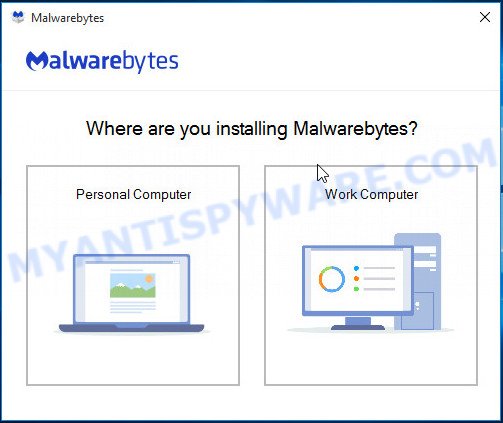
Once installation is done, you will see window such as the one below.
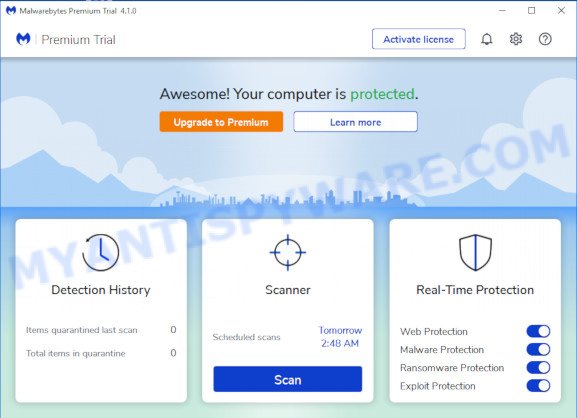
Now press the “Scan” button to perform a system scan with this tool for the Cosw ransomware and other security threats. This procedure can take quite a while, so please be patient. While the MalwareBytes program is scanning, you can see number of objects it has identified as threat.
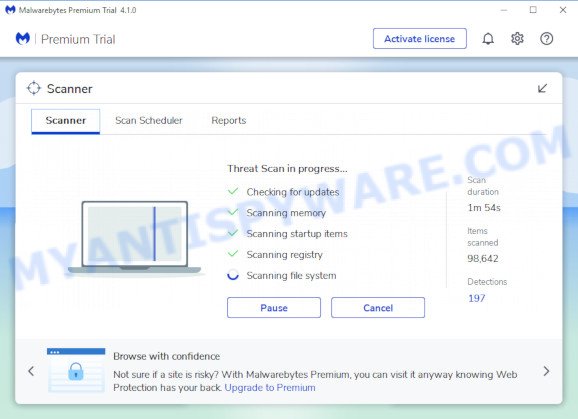
When the scan get completed, it will display the Scan Results. When you’re ready, press “Quarantine” button.
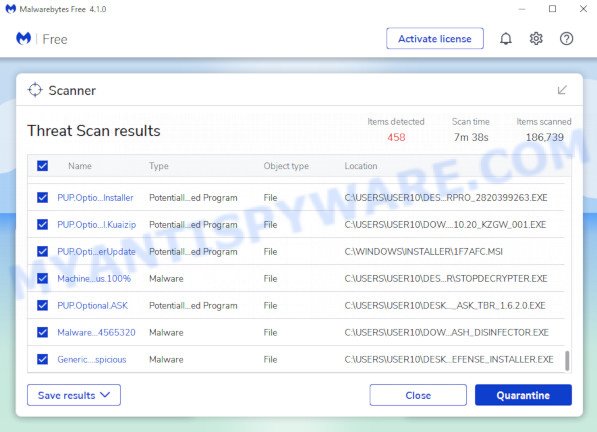
Malwarebytes will now move the selected security threats to the Quarantine. After the process is complete, you may be prompted to restart your computer.
In order to be 100% sure that the computer no longer has the Cosw virus, we recommend using the Kaspersky virus removal tool (KVRT). It is free and easy to use. It can scan and remove ransomware, spyware, potentially unwanted applications, worms, trojans, adware and other malware. KVRT is powerful enough to find and uninstall malicious registry entries and files that are hidden on the machine.
Download Kaspersky virus removal tool from the following link. Save it to your Desktop.
129312 downloads
Author: Kaspersky® lab
Category: Security tools
Update: March 5, 2018
When downloading is finished, double-click on the Kaspersky virus removal tool icon. Once initialization process is finished, you will see the KVRT screen as shown in the figure below.
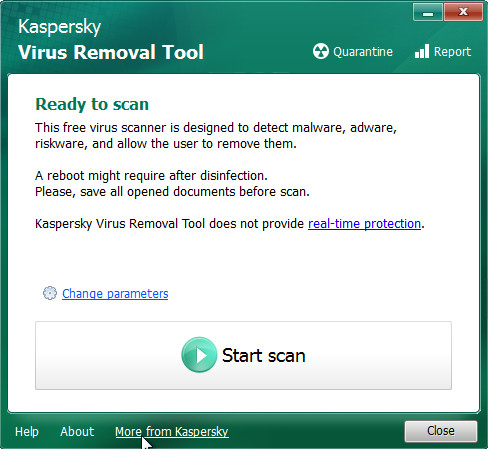
Click Change Parameters and set a check near all your drives. Press OK to close the Parameters window. Next click Start scan button . KVRT tool will begin scanning the whole PC to detect the Cosw ransomware. This procedure can take some time, so please be patient.
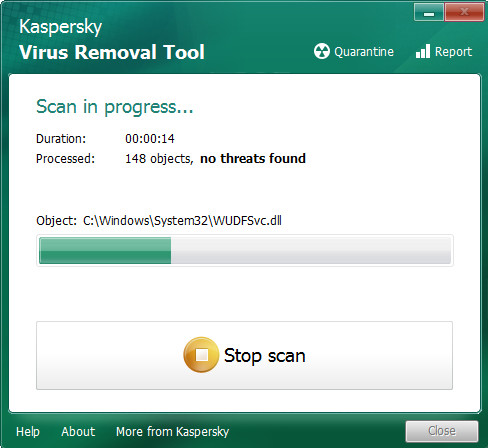
When Kaspersky virus removal tool has completed scanning, it will open the Scan Results like below.
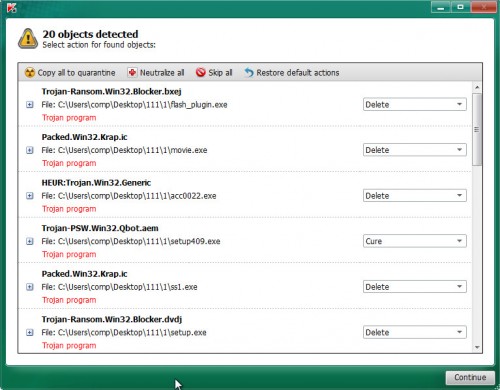
Review the results once the utility has finished the system scan. If you think an entry should not be quarantined, then uncheck it. Otherwise, simply click on Continue to begin a cleaning process.
How to decrypt .Cosw files
Files that have the extension ‘.Cosw’ have been encrypted and cannot be unlocked by simply renaming or changing the file name. To access the contents of these files, a decryptor is required. Thankfully, there is a Cosw File Decrypt Tool available that can decrypt these files for free. Instructions on how to download and use this tool are provided below.
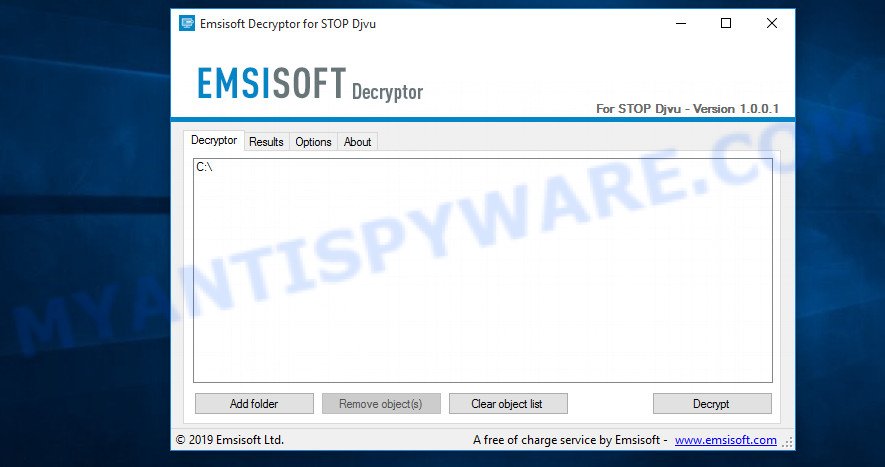
Cosw File Decrypt Tool (STOP Djvu decryptor)
To decrypt .Cosw files, use Cosw File Decrypt Tool
- Download Cosw File Decrypt Tool from the following link.
STOP Djvu decryptor - Scroll down to ‘New Djvu ransomware’ section.
- Click the download link and save the ‘decrypt_STOPDjvu.exe’ file to your desktop.
- Run decrypt_STOPDjvu.exe, read the license terms and instructions.
- On the ‘Decryptor’ tab, using the ‘Add a folder’ button, add the directory or disk where the encrypted files are located.
- Click the ‘Decrypt’ button.
The Cosw File Decrypt Tool is a free solution that enables anyone to decrypt .Cosw files at no cost. However, it is important to note that the decryptor can only decrypt files that were encrypted using an offline key. If the files were encrypted with an online key, then the free decryptor will not be of any use. Nevertheless, there are alternative methods available to restore encrypted files in such cases, which are explained below.
How to find out which key was used to encrypt files
Since Cosw File Decrypt Tool only decrypts files encrypted with the offline key, each Cosw’s victim needs to find out which key was used to encrypt the files. Determining the type of key used is not difficult. Below we give two ways. Use any of them. We recommend using the second method, as it is more accurate.
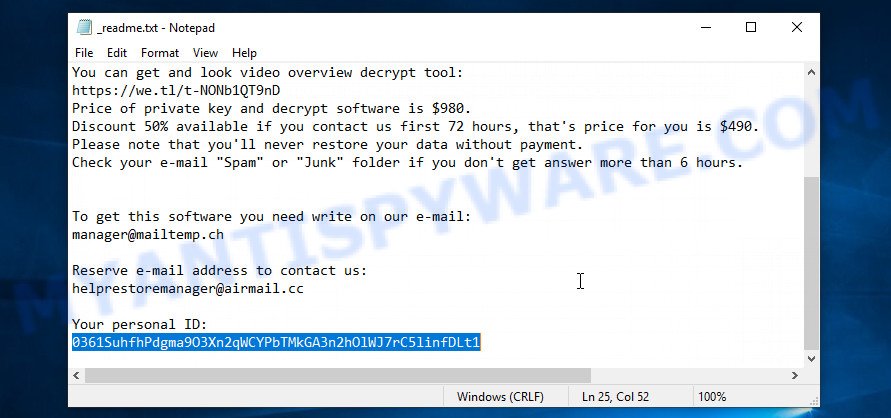
Personal ID is highlighted here
Find out the type of key using ‘_readme.txt’ file
- Open the ransom demand message (‘_readme.txt’ file).
- Scroll down to the end of the file.
- There you will see a line with the text ‘Your personal ID’.
- Below is a line of characters that starts with ‘0658’ – this is your personal id.
Find out the type of key using ‘PersonalID.txt’ file
- Open disk C.
- Open directory ‘SystemID’.
- Open file named ‘PersonalID.txt’. This file lists ‘Personal ID’s that match the keys that the virus used to encrypt files.
The ‘Personal ID’ is not a key, it is an identifier related to a key that was used to encrypt files. If the ID ends with ‘t1’, then the files are encrypted with an offline key. If the ID does not end with ‘t1’, Cosw virus used an online key. If you could not figure out how to determine which key was used to encrypt files, then we can help. Just write a request here or in the comments below.
Cosw File Decrypt Tool : “No key for New Variant online ID”
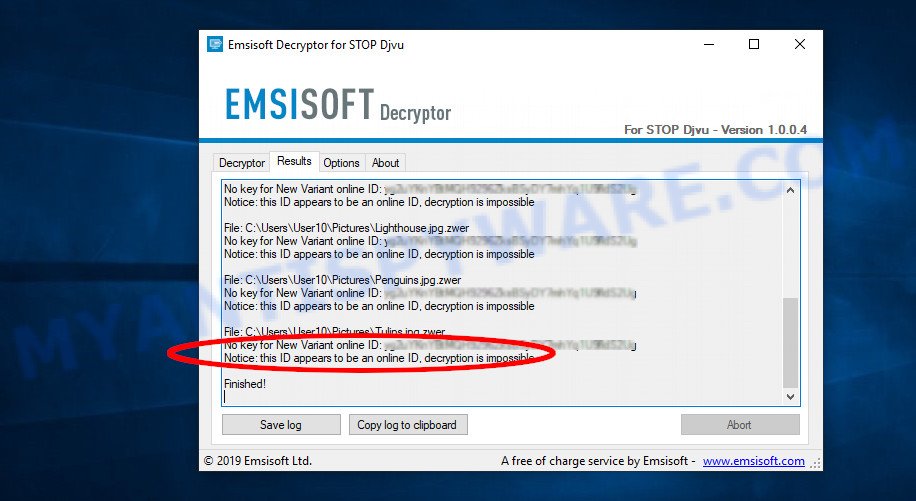
If, when you try to decrypt .Cosw files, Cosw File Decrypt Tool reports:
No key for New Variant online ID: *
Notice: this ID appears to be an online ID, decryption is impossible
It means that your files are encrypted with an ‘online key’ and their decryption is impossible, since only the vari authors have the key necessary for decryption. In this case, you need to use alternative methods listed below to restore the contents of encrypted files.
Cosw File Decrypt Tool : “No key for New Variant offline ID”
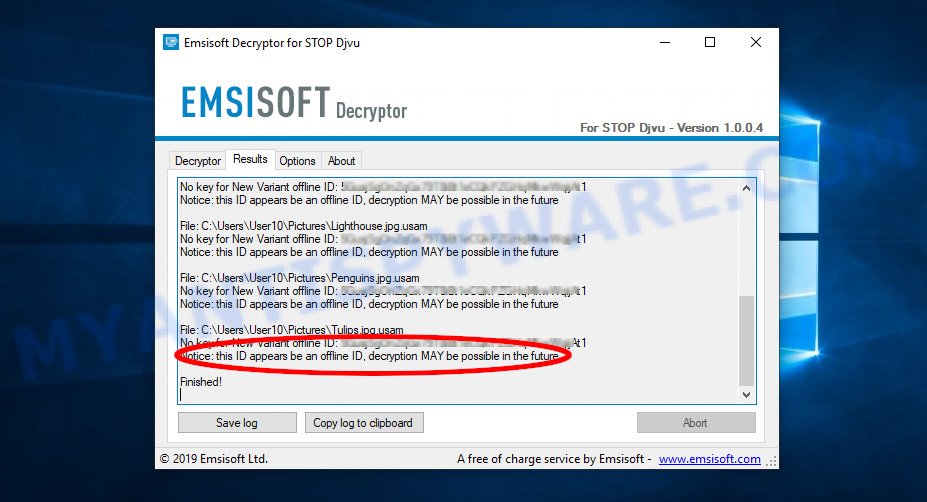
If, during decryption of .Cosw files, Cosw File Decrypt Tool reports:
No key for New Variant offline ID: *t1
Notice: this ID appears be an offline ID, decryption MAY be possible in the future.
It means the following: your files are encrypted with an ‘offline key’, but the key itself has not yet been obtained by security researchers, in this case, you need to be patient and wait a while, in addition, you can also use alternative ways for recovering encrypted data.
If for some reason you were unable to decrypt the encrypted files, then We recommend to follow the news on our Facebook or YouTube channels. So you ‘ll know right away that it ‘s possible to decrypt .Cosw files.
This video step-by-step guide will demonstrate How to use STOP Djvu decryptor to decrypt encrypted files.
How to restore .Cosw files
As previously mentioned, the Cosw File Decrypt Tool is only capable of decrypting files that were encrypted using the ‘offline key’. But what happens if the files were encrypted with an ‘online key’? In this case, there are still several alternative methods available to restore the contents of the encrypted files. These methods do not require a decryptor or unique key held by the cyber criminals. However, it is highly recommended that you perform a full computer scan to ensure that the Cosw ransomware has been completely removed. To locate and remove the ransomware, you can use a variety of free malware removal tools.
Recover .Cosw files with ShadowExplorer
The Windows operating system, including versions 11, 10, 8, 7, and Vista, includes a useful feature where it automatically creates copies of files that have been modified or deleted. These copies are known as “Shadow copies,” and they can be used to recover previous versions of files that were accidentally deleted or damaged or encrypted. A tool called ShadowExplorer can help in recovering files from these Shadow copies, and it is simple to use. However, many ransomware strains delete Shadow copies to prevent this method of recovering encrypted files. Despite this, it is still worth trying this method to recover files.
Visit the following page to download the latest version of ShadowExplorer for MS Windows. Save it on your Microsoft Windows desktop or in any other place.
439713 downloads
Author: ShadowExplorer.com
Category: Security tools
Update: September 15, 2019
After the downloading process is done, open a directory in which you saved it. Right click to ShadowExplorer-0.9-portable and select Extract all. Follow the prompts. Next please open the ShadowExplorerPortable folder as shown on the screen below.
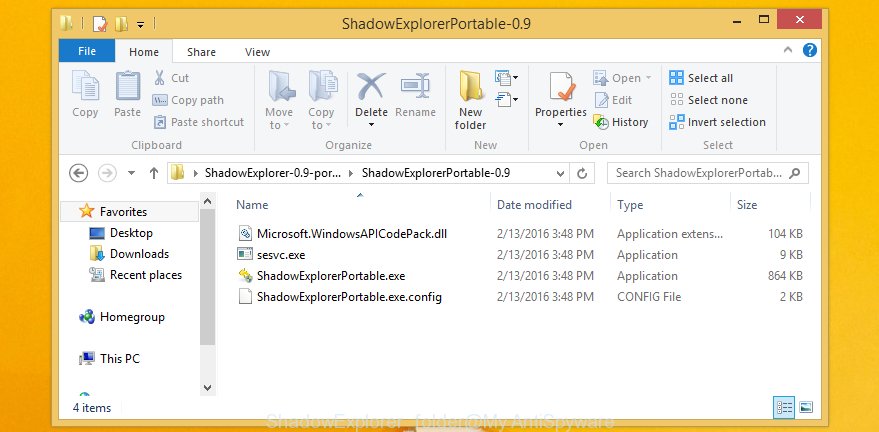
Start the ShadowExplorer utility and then choose the disk (1) and the date (2) that you wish to recover the shadow copy of file(s) encrypted by the Cosw virus as displayed on the image below.
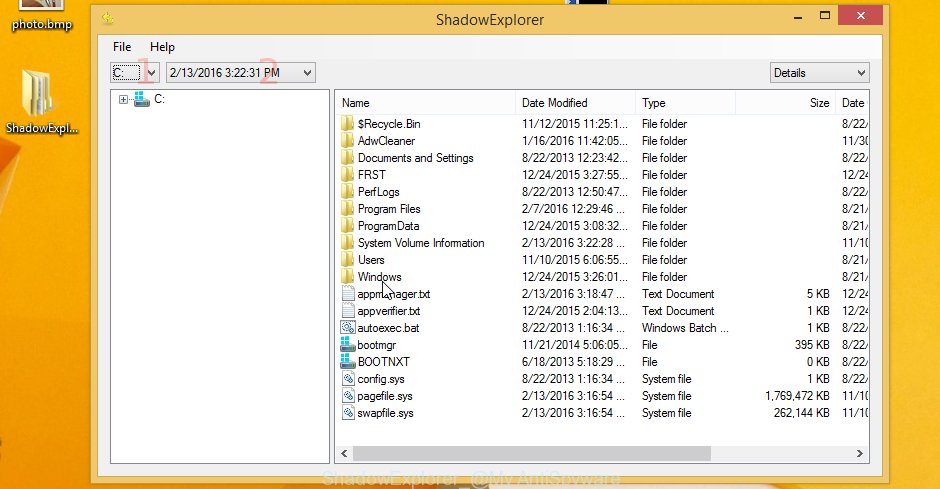
Now navigate to the file or folder that you wish to recover. When ready right-click on it and click ‘Export’ button like below.

This video step-by-step guide will demonstrate How to recover encrypted files using Shadow Explorer.
Use PhotoRec to restore .Cosw files
Another alternative way to recover encrypted files is to use data recovery tools. We recommend using a program called PhotoRec. This tool is free and does not require installation. Below we will show in detail how to use it to restore encrypted files.
Download PhotoRec on your Windows Desktop by clicking on the following link.
When downloading is done, open a directory in which you saved it. Right click to testdisk-7.0.win and choose Extract all. Follow the prompts. Next please open the testdisk-7.0 folder as shown in the following example.

Double click on qphotorec_win to run PhotoRec for MS Windows. It’ll open a screen as displayed in the figure below.
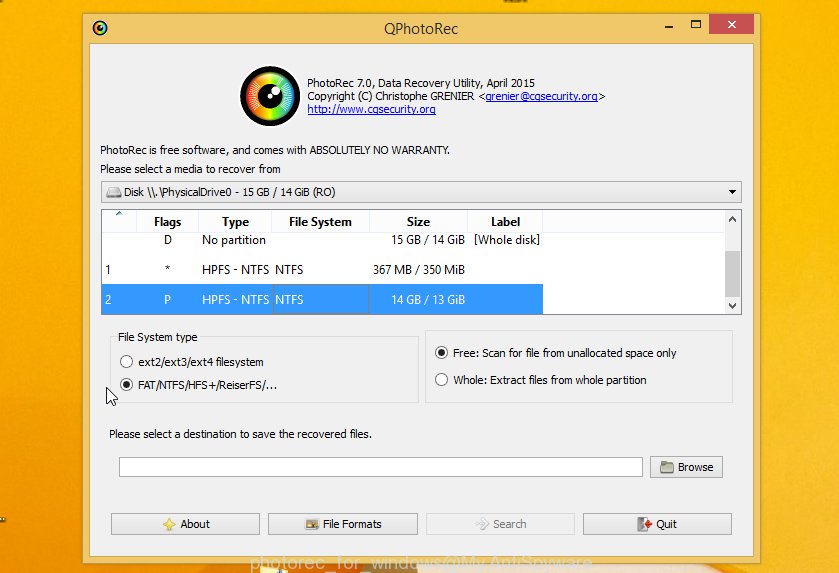
Select a drive to recover as shown on the screen below.

You will see a list of available partitions. Select a partition that holds encrypted documents, photos and music as displayed on the screen below.

Click File Formats button and choose file types to recover. You can to enable or disable the restore of certain file types. When this is done, click OK button.
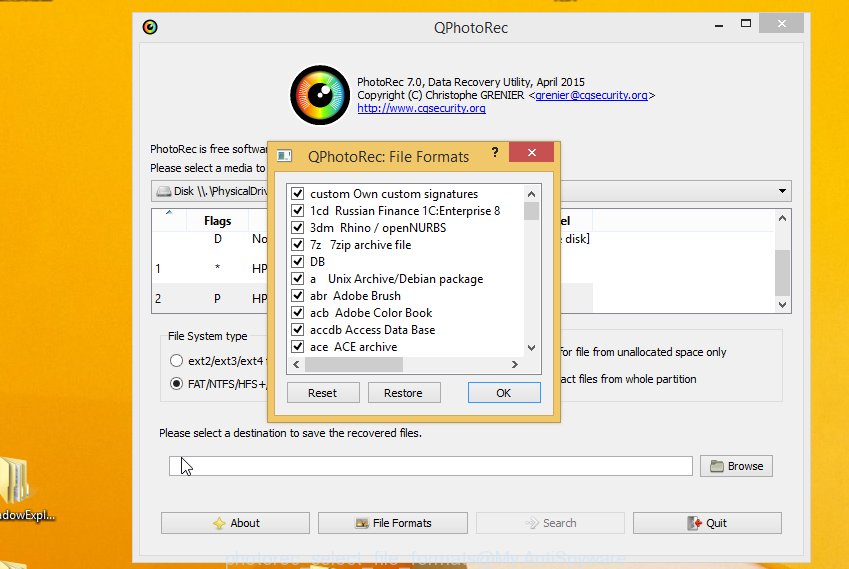
Next, click Browse button to choose where restored photos, documents and music should be written, then click Search. We strongly recommend that you save the recovered files to an external drive.
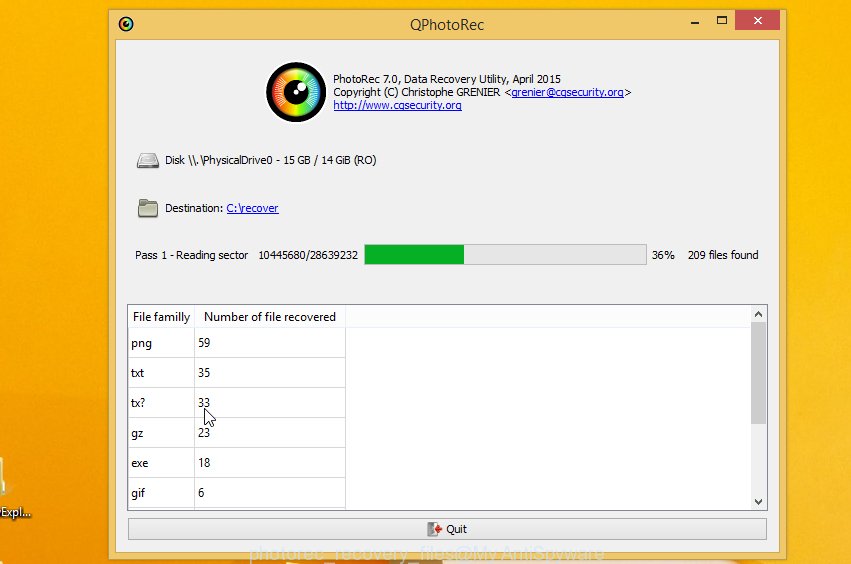
Count of recovered files is updated in real time. All restored personal files are written in a folder that you have chosen on the previous step. You can to access the files even if the restore process is not finished.
When the recovery is finished, click on Quit button. Next, open the directory where restored personal files are stored. You will see a contents like below.
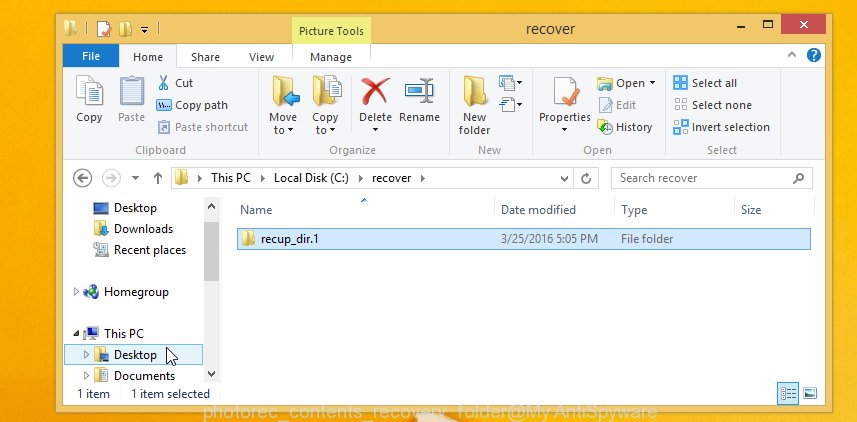
All recovered files are written in recup_dir.1, recup_dir.2 … sub-directories. If you’re looking for a specific file, then you can to sort your restored files by extension and/or date/time.
This video step-by-step guide will demonstrate How to recover encrypted files using PhotoRec.
How to protect your PC from Cosw ransomware
Most antivirus apps already have built-in protection system against the ransomware. Therefore, if your personal computer does not have an antivirus program, make sure you install it. As an extra protection, run the HitmanPro.Alert. All-in-all, HitmanPro.Alert is a fantastic tool to protect your computer from any ransomware. If ransomware is detected, then HitmanPro.Alert automatically neutralizes malware and restores the encrypted files. HitmanPro.Alert is compatible with all versions of MS Windows operating system from Windows XP to Windows 10.
Installing the HitmanPro Alert is simple. First you’ll need to download HitmanPro.Alert by clicking on the link below. Save it directly to your Microsoft Windows Desktop.
When the download is done, open the file location. You will see an icon like below.

Double click the HitmanPro Alert desktop icon. When the tool is launched, you will be displayed a window where you can choose a level of protection, as shown on the screen below.
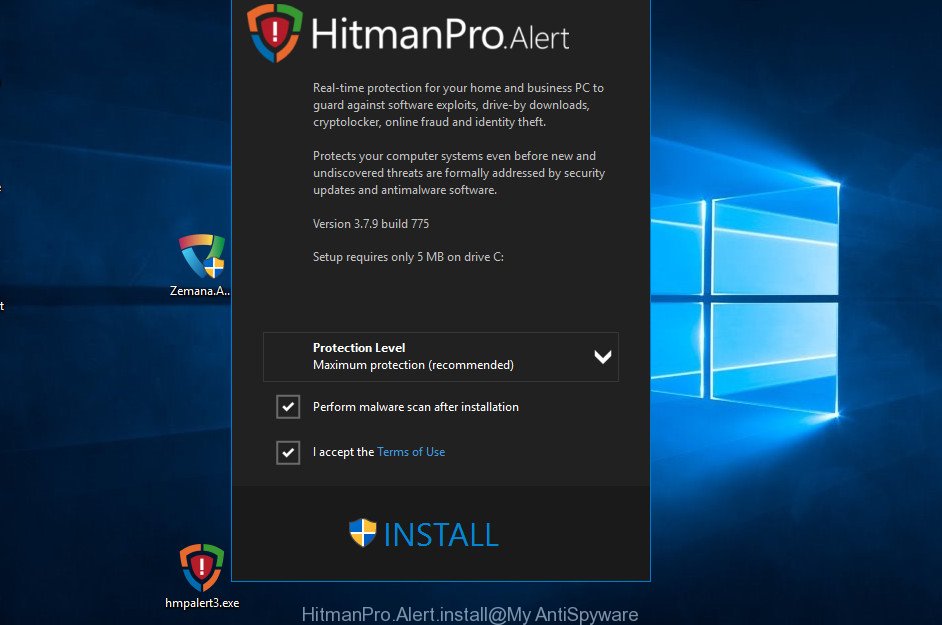
Now press the Install button to activate the protection.
To sum up
In summary, the purpose of this guide is to assist those who have been impacted by the Cosw ransomware virus. Our aim is to provide helpful insights on how to eliminate the ransomware, decrypt .Cosw files, and restore encrypted files. In addition, we also explain the differences between an online key and an offline key. We sincerely hope that the information we have provided in this guide has proven to be useful for you.
If you have questions, then write to us, leaving a comment below. If you need more help with Cosw ransomware related issues, go to here.
